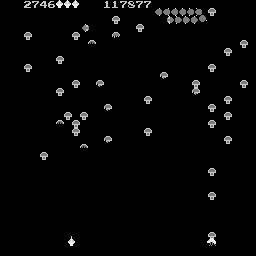Interconnectedness
One of the great strengths of Centipede is how well all the different elements of the gameplay fit together. Consider the different enemy insects that try to kill players. The centipede winds its way down from the top of the screen to the player s area at the bottom, moving horizontally. The centipede appears as either a lone twelve-segment centipede or as a shorter centipede accompanied by a number of single heads. At the start of a wave, the number of centipede segments on the screen always totals twelve. Next is the spider, which moves in a diagonal, bouncing pattern across the bottom of the screen, passing in and out of the player s area. Then comes the flea, which plummets vertically, straight down. There is nothing terribly sophisticated about any of the movement patterns of these insects. Indeed, the flea and the centipede, once they have appeared in the play-field, follow a completely predictable pattern as they approach the player s area. The spider has a more random nature to its zigzagging movement, but even it does nothing to actually pursue players. Therefore, once players have played the game just a few times, they have a completely reliable set of expectations about how these enemies will attack them. Fighting any one of these creatures by itself would provide very little challenge for players. Yet, when they function together they combine to create uniquely challenging situations for players. With any one of these adversaries missing, the game s challenge would be significantly diminished, if not removed altogether.
Each of the insects in the game also has a unique relationship to the mushrooms, which fill the game s play-field. The primary reason for the existence of the mushrooms is to speed up the centipede s progress to the bottom of the screen. Every time a centipede bumps into a mushroom, it turns down to the next row below, as if it had run into the edge of the play-field. Thus, once the screen becomes packed with mushrooms, the centipede will get to the bottom of the play-field extremely quickly. Once at the bottom of the screen, the centipede moves back and forth inside the player s area, posing a great danger to players. So, it behooves players to do everything they can to destroy the mushrooms on the play-field, even though the mushrooms themselves do not pose a direct threat. Further complicating matters, every time players shoot a segment of the centipede it leaves a mushroom where it died. Thus, wiping out a twelve-segment centipede leaves a big cluster of mushrooms with which players must contend.

In Centipede , fleas drop toward the bottom of the screen, leaving mushrooms behind them, while spiders eat whatever mushrooms block their movement.
As the flea falls to the bottom of the play-field, it leaves a trail of new mushrooms behind itself, and the only way for players to stop it is to kill it. The flea only comes on to the play-field if less than a certain number of mushrooms are on the bottom half of the screen. This way, if players destroy all the mushrooms closest to them, the flea comes out immediately to lay down more. The spider, the creature that poses the biggest threat to players, has the side effect that it eats mushrooms. This then presents players with a quandary : shoot and kill the spider or just try to avoid it so it can take out more mushrooms? Finally, the scorpion , a creature that travels horizontally across the top half of the screen and hence can never collide with and kill players, poisons the mushrooms it passes under. These poisoned mushrooms affect the centipede differently when it bumps into them. Instead of just turning down to the next row, the centipede will move vertically straight down to the bottom of the screen. So when a centipede hits a poisoned mushroom, the centipede becomes a much more grave threat than it was before. Once a scorpion has passed by, players must now expend effort trying to shoot all the poisoned mushrooms at the top of the screen or be prepared to blast the centipedes as they plummet vertically straight toward them.
So we can see that each of the creatures in the game has a special, unique relationship to the mushrooms. It is the interplay of these relationships that creates the challenge for players. The more mushrooms the flea drops , the more mushrooms the scorpion has to poison . The spider may take out mushrooms along the bottom of the screen, getting them out of the way of players, but it may eat so many that the flea starts coming out again. If players kill the centipede too close to the top of the screen, it will leave a clump of mushrooms that are difficult to destroy at such a distance and that will cause future centipedes to reach the bottom of the screen at a greater speed. However, if players wait until the centipede is at the bottom of the screen, the centipede is more likely to kill them. With the mushrooms almost functioning as puzzle pieces, Centipede becomes something of a hybrid between an arcade shooter and a real-time puzzle game. Indeed, some players were able to develop special strategies that would work to stop the flea from ever coming out, thus making the centipede get to the bottom of the screen less quickly and allowing players to survive much longer. It is the interplay of each of the adversaries with these mushrooms and with each other that creates a unique challenge for players.
EAN: 2147483647
Pages: 189